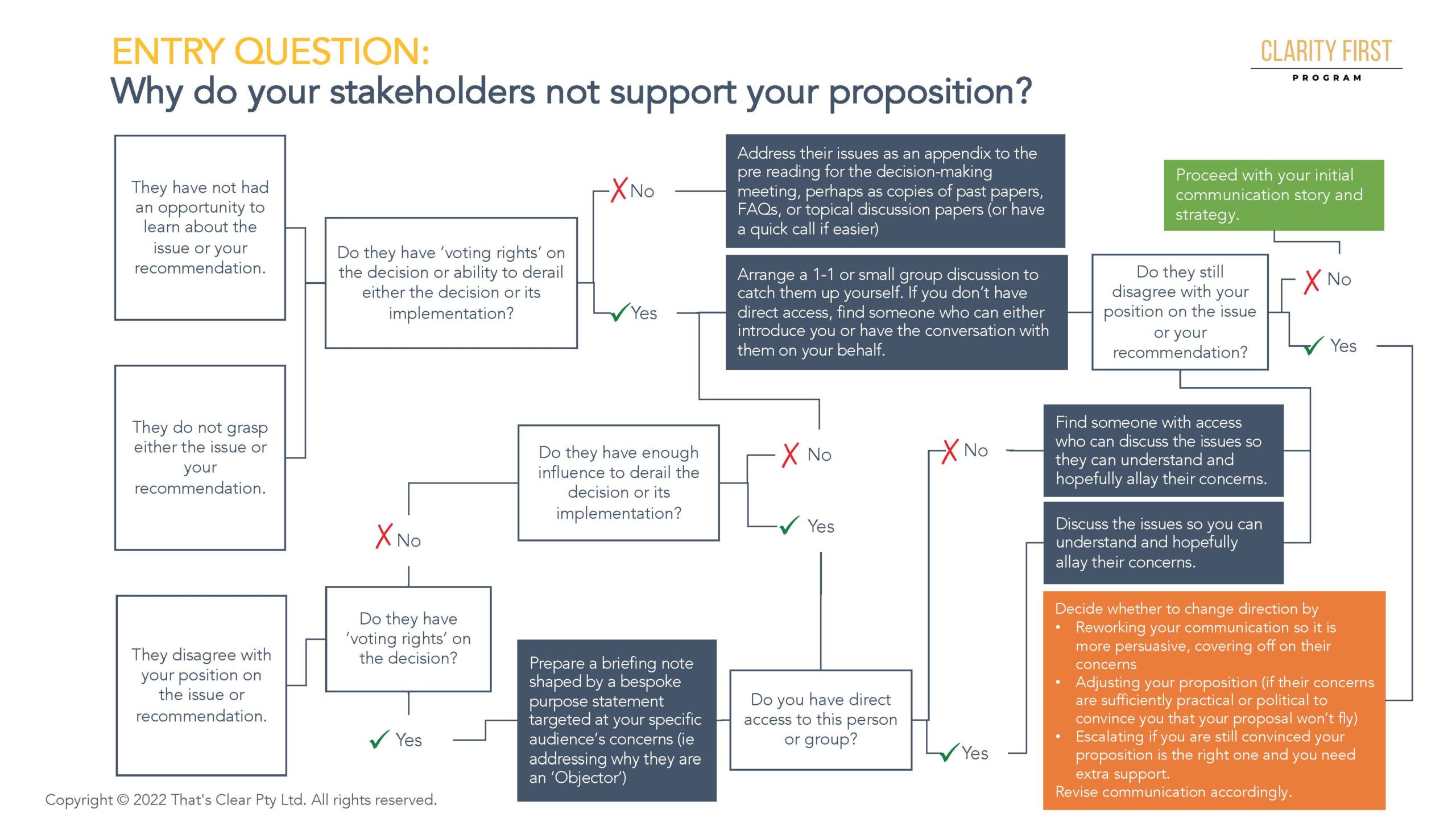×

LEARN MORE ABOUT THE WORKSHOP KIT
Enter your email below and we will keep you updated as more information is released about the kit.

I was recently asked a wonderful question:
The client and I had a terrific discussion and I mapped the outcome as a decision tree to share with you all.
The tree offers a series of decision points that we must navigate if we are to deliver a story that gets the result we need.

In this particular case, the issue centred around around a common problem, which was how to handle ‘the story' when key stakeholders don't agree with it. Do we ….
Tell the same story regardless?
Edit the story to accommodate that person (or those people) only?
Ask someone else to present on our behalf?
Create a separate story that deals with the objector's specific concerns?
Scrap the story and start again?
There are lots of alternatives, each of which might suit a different situation but none of which suit all.
Hence, the decision tree. I hope you find it useful.
Cheers, Davina

I love what I do.
I help senior leaders and their teams prepare high-quality papers and presentations in a fraction of the time.
This involves 'nailing' the message that will quickly engage decision makers in the required outcome.
I leverage 25+ years' experience including
My approach helps anyone who needs to engage senior leaders and Boards.
Recent clients include 7Eleven, KPMG, Mercer, Meta, Woolworths.
Learn more at www.clarityfirstprogram.com
(*) Numbers are based on 2023 client benchmarking results.

An email came across my desk this week as I was thinking about the most useful idea for you that would build on last week's focus of ‘saying what you mean'.
It was an email from a tool that I use which was structured around a list of questions (see below).
To me, using questions like this misses a big opportunity for a coherent story and makes the audience work far too hard to grasp the main idea. Here are the problems I see with structuring communication around questions with one caveat:
The problem: structuring communication around questions almost guarantees your audience will miss your point
#1 – By highlighting the questions in bold, you are prioritising it over the answer. This then leaves you exposed to the risk that the audience may decide your communication is not important enough to invest the time needed for them to find your message.
#2 – By using questions as the main structuring device, you are at risk of providing your audience with the raw data rather than a coherent message that describes what the data means to your audience.
I have often seen people identify the questions they need to answer to solve a problem, collect the evidence and then send the list of questions with their evidence underneath as their ‘communication'.
This strategy ensures that both you and your audience miss the point. Your audience is less likely to get your message in part because you haven't articulated it to yourself.
The caveat: FAQs can be useful when combined with a powerful story
As a final caveat, I do understand that there are times that it is useful to have a series of FAQs (frequently asked questions), perhaps at the end of a presentation or information package. You will have seen our own FAQs on our site, for example.
This is not the same as focusing your whole communication around the questions, which I would caution against.
Cheers, Davina
Keywords: #questions #synthesis #structure


I love what I do.
I help senior leaders and their teams prepare high-quality papers and presentations in a fraction of the time.
This involves 'nailing' the message that will quickly engage decision makers in the required outcome.
I leverage 25+ years' experience including
My approach helps anyone who needs to engage senior leaders and Boards.
Recent clients include 7Eleven, KPMG, Mercer, Meta, Woolworths.
Learn more at www.clarityfirstprogram.com
(*) Numbers are based on 2023 client benchmarking results.

In my recent webinar one of the participants, Rob asked an interesting question: when sitting on a board, what do you do if the business leaders consistently do not answer your questions?
He mentioned that he and other board members were finding this to be a problem: when asked a question, the leaders would ‘beat around the bush' and not answer it.
The key is to understand why they are not answering the questions and then to respond accordingly.
There could be all sorts of reasons why someone does not answer your question, but they would I think fall into three potential categories: they don't know the answer, they don't know how to provide the answer or they don't want to provide the answer.
In most instances, the problem is more likely to be caused by either not knowing the answer, or not knowing how to explain it succinctly, although not wanting to provide it can't be ruled out.
Here are a few ideas for thinking that through:
Not wanting to answer
This is the hardest of all and requires a judgement call: work out why they don't want to answer and act accordingly. It could be that they are afraid of getting the answer wrong, that they are concerned about the political risks of answering correctly, or that they have something to hide. Either way, it is important to understand why they are not wanting to answer before responding. If they are afraid of getting it wrong, encouragement would work better, however if they have something to hide no amount of encouragement will help.
Not knowing how to answer
In this area it is hard for me to avoid offering some of our tools to help. Here are some free options:
Not knowing the answer
This one is the easiest of all to fix: Give them advance warning by providing important questions before the meeting. When doing so, add extra contextual information in your request so you can be confident that they understand the context of the request and can tailor their response accordingly.
For example, general requests such as “update me on the state of the widget market” are not as useful as “please explain your view on the future of the widget market in light of new XYZ technologies that will come on stream over the coming two years”.
I hope this helps – if you would like more on this topic, download the full set of FAQs from the webinar here.
Keywords: leadership

I love what I do.
I help senior leaders and their teams prepare high-quality papers and presentations in a fraction of the time.
This involves 'nailing' the message that will quickly engage decision makers in the required outcome.
I leverage 25+ years' experience including
My approach helps anyone who needs to engage senior leaders and Boards.
Recent clients include 7Eleven, KPMG, Mercer, Meta, Woolworths.
Learn more at www.clarityfirstprogram.com
(*) Numbers are based on 2023 client benchmarking results.